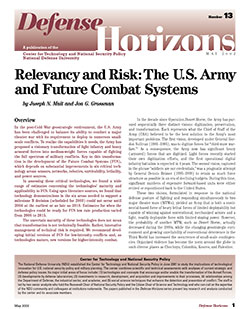Overview
 In the post-Cold War geostrategic environment, the U.S. Army has been challenged to balance its ability to conduct a major theater war with its requirement to deploy to numerous small-scale conflicts. To realize the capabilities it needs, the Army has proposed a visionary transformation of light infantry and heavy armored forces into medium-weight forces capable of fighting the full spectrum of military conflicts. Key to this transformation is the development of the Future Combat Systems (FCS), which depends on substantial improvements in six critical technology areas: sensors, networks, robotics, survivability, lethality, and power sources.
In the post-Cold War geostrategic environment, the U.S. Army has been challenged to balance its ability to conduct a major theater war with its requirement to deploy to numerous small-scale conflicts. To realize the capabilities it needs, the Army has proposed a visionary transformation of light infantry and heavy armored forces into medium-weight forces capable of fighting the full spectrum of military conflicts. Key to this transformation is the development of the Future Combat Systems (FCS), which depends on substantial improvements in six critical technology areas: sensors, networks, robotics, survivability, lethality, and power sources.
In assessing these critical technologies, we found a wide range of estimates concerning the technologies’ maturity and applicability to FCS. Using open literature sources, we found that technology demonstrations in the six areas needed to support a milestone B decision (scheduled for 2003) could not occur until 2004 at the earliest or as late as 2010. Estimates for when the technologies could be ready for FCS low rate production varied from 2006 to 2015.
The uncertain maturity of these technologies does not mean that transformation is not technically feasible. Rather, innovative management of technical risk is required. We recommend developing initial versions of FCS for low-intensity conflicts and, as technologies mature, new versions for higher-intensity combat.
READ MORE >>